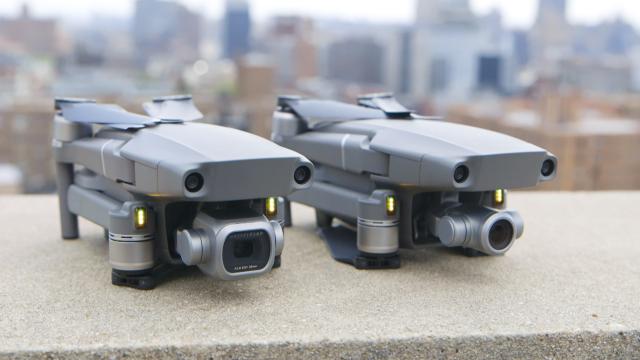We’ve known for some time that the future of consumer drones would be tiny, high quality, and mostly crash-proof. DJI just revealed its best attempt at all three with the new Mavic 2 series. There are two of them: the Mavic 2 Pro and the Mavic 2 Zoom. They fold up. They have great cameras. And in a first for DJI, they have omni-directional obstacle sensing.
The Mavic 2 drones actually feature the same drone body but have two different camera and gimbal setups. You can buy the Mavic 2 Pro, which includes a Hasselblad camera with a one-inch sensor, for $2299. Or you can buy the Mavic 2 Zoom, which includes a camera with a 1/2.3-inch sensor with 2X optical zoom and 4X digital zoom, for $1999.
Both of them feature a redesigned body that DJI says is more aerodynamic and offers a maximum speed of 71km-per-hour and a maximum flight time of 31 minutes. There’s also 8 gigabytes of on-board storage. Like the original Mavic Pro, the Mavic 2 folds up into a form factor that’s, as I’ve said before, about the size of a large sandwich.
For reference, DJI’s past flagship drone, the Phantom 4 Pro, features a one-inch sensor, does not fold up, and sells for $2399.
But you probably don’t want to buy a Phantom any more, even though DJI will keep selling them. Based on our initial impressions, the Mavic 2 Pro simply offers more. The new 20-megapixel camera and its one-inch sensor looks a lot like the Phantom’s camera, but the Mavic 2 comes with a whole bag of new tricks.
Those include 10 sensors on all sides of the drone that give it that omnidirectional obstacle sensing. The Mavic 2 series also offers a new autonomous tracking mode called ActiveTrack 2.0. That enables the drone to create a 3D map of the area in front of its camera and predict where the selected subject will go next. Tree in the way? No problem. The Mavic 2 will fly around it.
The cameras are the real stars of the new Mavic 2 series, though. The camera system on the Mavic 2 Pro was developed with help from Hasselblad over the past two years. Again, it features a one-inch sensor that can capture 20-megapixel images and features an adjustable aperture that goes from f/2.8 to f/11.
According to DJI, the Mavic 2 Pro camera also offers 4K 10-bit HDR support and can capture “four times as many levels of colour per channel” than the original Mavic Pro. Those colours will supposedly be more accurate thanks to something called the Hasselblad Natural Colour Solution. That’s an incredibly buzzwordy offering, but the dimensions of the sensor alone suggest that the Mavic 2 Pro’s camera is superior.
It’s more than twice the size of the sensor on the first generation Mavic Pro.
Meanwhile, the Mavic 2 Zoom promises something new: zoom! While DJI has offered optical zoom on its pricey professional-grade drone cameras, this is the first consumer drone with the feature. The ability to zoom simply means you can do more things with the camera. It also opened the door for a new Quickshot mode called DollyZoom.
With one tap in the DJI GO app, this is a trippy effect that involves the drone moving away from a subject while the camera zooms in. It looks like the subject is staying in one place while the whole world warps around it. And the coolest thing is that if you decide you’d rather have the Hasselblad camera instead of the zoom camera (or vice versa), you can take the drone to a DJI dealer and swap out the camera systems.
What could be the coolest intelligent flight feature of them all is a new one called Hyperlapse. This autonomous mode crates a moving timelapse image that would typically require a bunch of equipment and expertise. It’s mesmerising.
Flashy new features aside, the Mavic 2 Pro is also supposed to fly quieter and more smoothly than its predecessor. While we had a quick hands on with the drone at the DJI offices in New York, we’re working on a full review and will weigh in more on just how different the new camera setups are. On paper and at first glance, though, the Mavic 2 series looks impressive. May the Phantom rest in peace.
